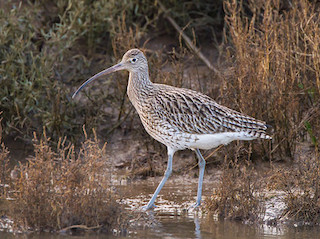 Watch out for Curlews in July and August as they start to move to the coast.
Watch out for Curlews in July and August as they start to move to the coast.
Photo: © Natural England/AllanDrewitt
Scientific name: Numenius arquata
Other common names: Eurasian Curlew, Common Curlew, Whaup (in Scotland)
Cornish name:Mengelvinick
Conservation status: UK Birds of Conservation Concern, Amber; IUCN Red List, Near Threatened.
What to look for:
- Colouring and appearance: Large wading bird, long downward-curved bill, grey-brown colouring speckled with darker streaks, white rump.
- Size: Length 48 to 57 cm (including bill); wingspan 89 to 106 cm.
- Where: In winter, and when on passage, Curlews are usually found in flocks around the whole British coast, estuaries, mudflats and marshy grassland. From April to July they breed on inland pastures and coastal meadows. The highest numbers of breeding birds are found in Wales, Scotland, Ireland and more northerly parts of England.
- Call: http://www.xeno-canto.org/37497
- Similar species: The less common Whimbrel, a species that, in the UK, only breeds in northern Scotland, may be seen elsewhere as a migrant on its way to or from its wintering grounds in South Africa. Its bill is not as long as the Curlew, and curves towards the tip in comparison with the Curlew’s more uniform curve.
“I take my gladness in…the sound of the curlew instead of the laughter of men.”
 So said the anonymous writer of the Anglo-Saxon poem The Seafarer. The melancholy cry of the Curlew is a wistful accompaniment to summer across its breeding areas in the moorlands and wet meadows of Britain. It is this call – a curloo-oo – that gives the large wader its common name. It is an impressive bird whether in flight or on the ground, with its famously long curved bill and slow wing beats.
So said the anonymous writer of the Anglo-Saxon poem The Seafarer. The melancholy cry of the Curlew is a wistful accompaniment to summer across its breeding areas in the moorlands and wet meadows of Britain. It is this call – a curloo-oo – that gives the large wader its common name. It is an impressive bird whether in flight or on the ground, with its famously long curved bill and slow wing beats.
In the breeding season (April to July), Curlews can be found on the marshes and wet grasslands of Wales, Scotland, Ireland and northern England. They lay a single clutch of up to four eggs in a scrape on the ground; incubation takes up to 29 days, and the young fledge after 32 to 38 days. Outside of the breeding season, Curlews can be found across Britain, sometimes in flocks, mainly by the coast and on marshes and mudflats. They will have migrated there or are passaging through on their way to overwintering grounds further south in southern Europe and Africa. Britain has a resident population due to its relatively mild climate.
There has been a steep decline in Curlew numbers in Britain, which may host up to one quarter of the global breeding population. Possible causes include nest predation, low breeding productivity or changes in habitats.
Did you know…?
…Bird of the New Moon: the Curlew’s scientific name is descriptive of its bill shape. The genus name Numenius is derived from the Greek for new moon, suggesting the crescent shape of the bill. The species name of arquata is derived from the Latin for bow-shaped.
…The maximum age recorded for a Curlew is 32 years and seven months, but they more typically live for an average of five years.
More information and references:
Svensson, L., Mullarney, K., Zetterstrom, D.,1986. Collins Bird Guide, second edition (translated by Christie, D., Svensson, L.). HarperCollins, London.

Published: August 2014
Author: Amanda Scott
Photos: © Natural England/AllanDrewitt (upper); Amanda Scott (lower)
